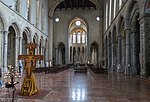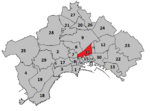Santa Maria della Colonna
16th-century Roman Catholic church buildings in Italy18th-century Roman Catholic church buildings in ItalyBaroque architecture in NaplesChurches in Naples

Santa Maria della Colonna is a Baroque style deconsecrated Roman Catholic church in central Naples, region of Campania, Italy. It stands across from the church of the Girolamini.
Excerpt from the Wikipedia article Santa Maria della Colonna (License: CC BY-SA 3.0, Authors, Images).Santa Maria della Colonna
Via dei Tribunali, Naples Pendino
Geographical coordinates (GPS) Address External links Nearby Places Show on map
Geographical coordinates (GPS)
| Latitude | Longitude |
|---|---|
| N 40.851374 ° | E 14.2587 ° |
Address
Santa Maria della Colonna
Via dei Tribunali
80138 Naples, Pendino
Campania, Italy
Open on Google Maps










